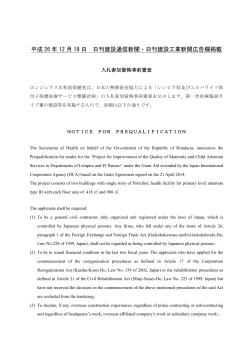
JICA ’s Strategic Plan in
<Summary version> JICA’s Strategic Plan 2014-2020 in Nature Conservation Sector As of October. 14, 2014 Mr. SHISHIDO Kenichi Deputy Director General for Nature Conservation, Global Environment Department, Japan International Cooperation Agency Goal & Strategic Objectives Overall Goal of JICA Harmonization between Nature Conservation and Human Activities 4 Strategic Objectives of JICA Sustainable Forest Management For Global Warming (REDD plus) For Strengthening Resilience Sustainable Natural Resources Usage in Marginal Community Biodiversity Conservation UNCCD UNCBD 3 International Agenda UNFCCC Mitigation Adaptation +RAMSAR , UNESCO/MAB etc. Objectives & Approach 4 Strategic Objectives Sustainable Forest Management For Global Warming (REDD plus) For Strengthening Resilience • To strengthen “Readiness of REDD+ (MRV, Pilot activity etc.)” in tropical countries • To collaborate with private sector in carbon business & CSR • To introduce appropriate methodology to mitigate Natural Disaster (Watershed Management, Costal Protection) • To introduce mechanism such as PES(Payment for Ecosystem Services) Sustainable Natural Resources Usage Biodiversity Conservation • To improve livelihood activities in venerable community of Arid or Semiarid countries through sustainable manner. • To improve management of Protected Area and Buffer zone through collaborative management • To mobilize mechanism such as PES(Payment for Ecosystem Services) Expected Outcome toward 2020 4 Strategic Objectives Sustainable Forest Management For Global Warming (REDD plus) For Strengthening Resilience Sustainable Natural Resources Usage Biodiversity Conservation Indicator (tentative) ●Readiness Support in 11 countries and 2 regional organization ●Forest Inventory for 4,500,000km2 ●REDD Plan for 750,000km2 (75 Mt ~/ year) ●5 Pilot REDD+ Projects with Private Sector ●Capacity Building for about 2,000 Person Expected Outcome toward 2020 4 Strategic Objectives Sustainable Forest Management For Global Warming (REDD plus) For Strengthening Resilience Indicator (tentative) Sustainable Natural Resources Usage Biodiversity Conservation Priority Region/Countries 4 Strategic Objectives Sustainable Forest Management For Global Warming (REDD plus) For Strengthening Resilience Sustainable Natural Resources Usage Biodiversity Conservation Sahel/Sahara Region Focal country Other Venerable Countries Latin America Priority Program Asia Asia-Pacific (Venerable Area) Africa Latin America (Watershed Management) (Central & South Africa) Amazon Component & Budget Major Component Budget(2014-2020): 900 million USD • Policy Support <tentative estimation> • Capacity Building Technical Cooperation • Awareness / Advocacy 300 million USD • Research / Development Yen Loan 550 million USD • Livelihood Improvement Grant Aid 50 million USD • Networking • South-south cooperation 7 JICA’s Contribution to Aichi Targets Widespread contribution to Aichi Targets Aichi Target 1 2 4 5 7 8 10 11 12 13 14 15 16 17 18 19 JICA Project in field of Biodiversity Conservation ◎●●●●●●●● People recognize the value of and actions for biodiversity. Integrate the value of biodiversity into national/regional plans, and into the national ◎●●●● accounts and reporting system when appropriate. All involved parties should implement plans for sustainable production and ◎● consumption. Reduce the loss of natural habitats including forests at least by half and close to ●●●●●● zero if possible, and noticeably reduce their degradation and fragmentation. Sustainably managed agriculture, aquaculture and forestry. ◎● Reduce pollution to non-harmful levels. ◎ Minimize adverse effects on ecosystems such as coral reefs that are vulnerable to ◎● climate change or acidification of the oceans. 17% of inland areas and 10% of ocean areas are conserved by protected areas, etc. ◎◎◎◎◎◎●●● Prevent the extinction or decline of threatened species. ●●●●● Maintain the diversity of the genes of crops and livestock animals, and minimize ◎ their loss. Provide, restore, and conserve the benefits of nature. ◎● Contribute to climate change mitigation and adaptation through the restoration of at ◎● least 15% of degraded ecosystem. Enforce and operate the Nagoya Protocol on ABS. ● The contracting parties develop and implement an effective and participatory ●● national strategy. Respect and mainstream traditional knowledge. ●●● 8 Improve knowledge and science and technology on biodiversity. ◎◎◎●●● ◎:Main Target ●:Relative Target Biodiversity Conservation JICA’s strength Effective synergy among types of JICA’s cooperation menu (Loan, Grant, Technical cooperation etc.) Capacity building for counterparts by collaboration with experts and trainings South-south cooperation for experts and trainings Further challenges Effective collaboration with other donors / international organizations (bilateral / multilateral organizations) Review of JICA’s achievement at COPs 13-15, and propose the recommendations after the year of 2020 9
© Copyright 2025





















